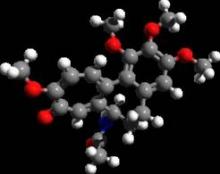One of the best things about generic drugs is also their Achilles heel: They’re relatively cheap. That makes them good for patients, for the health care system, and for society in general. But it also means that anyone trying to develop a new indication for a generic drug faces a big challenge: how to pay for a big study that proves the generic drug works.
Will this barrier come into play for colchicine as a potential treatment for stable coronary artery disease? Colchicine is an old anti-inflammatory drug, mostly used to treat gout, that had usually been very cheap, and it remains so throughout much of the world. But in October 2009, the Food and Drug Administration awarded a patent to URL Pharma (now owned by drug giant Takeda) for a branded formulation of colchicine, Colcrys, to treat gout on the basis of safety studies that URL funded. That caused the price of colchicine to soar to about $5 a dose. The patent on colchicine for gout treatment supposedly only lasted 3 years, but so far no generic versions have come onto the U.S. market.
It’s unclear how the controversy over colchicine’s patenting and pricing for gout will play into the report last month that the drug showed a promising, substantial benefit in patients with stable CAD. Briefly, a low dosage of 0.5 mg/day added to standard therapy cut the rate of major cardiovascular events by two-thirds when tested in a randomized controlled trial with 532 patients treated for a median of 3 years, Dr. Mark Nidorf reported at the annual Scientific Sessions of the American Heart Association in November.
It was an impressive result for colchicine, but both Dr. Nidorf, a cardiologist at the Heart Research Institute of Western Australia in Perth, and Dr. Shinya Goto, a Japanese cardiologist who served as the designated discussant for the study, agreed on what needs to come next. This promising finding from a single-center, phase II study needs confirmation in larger, multicenter trials, or at least in several similarly sized trials done in different groups of patients. And the question is who will pay for that?
The 532-patient LoDoCo (Low Dose Colchicine) study that ran for several years in Perth was paid for entirely by the Heart Research Institute.
I spoke with Dr. Nidorf after his talk about the prospects for wider testing of colchicine, and he did not sound optimistic. He felt that a bigger trial stood little chance of getting funding from the Australian government, and he wondered whether he and his associates could possibly get funding from a U.S. government agency.
Last April, Takeda announced that it had begun acquisition of URL Pharma for the express purpose of acquiring URL’s patent on colchicine for treating gout. Takeda also has a respectably sized presence in cardiovascular drugs. Will Takeda decide that it’s worth funding a major trial to test colchicine for treating stable CAD? So far, no word has come from the company about that, but it’s an intriguing possibility. The patenting of colchicine caused controversy and problems for gout patients when the drug’s price soared, but it may also give the best opportunity for pursuing a new CAD indication for this old drug.
--Mitchel L. Zoler (on Twitter @mitchelzoler)


